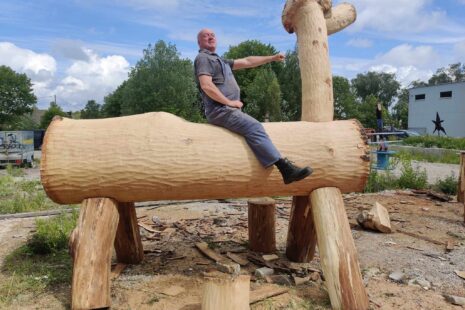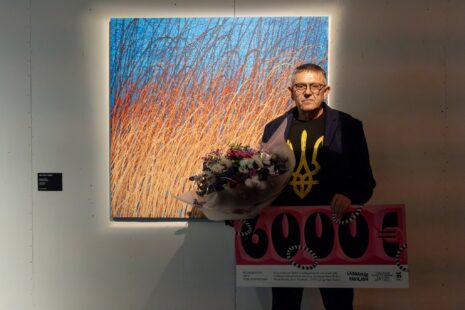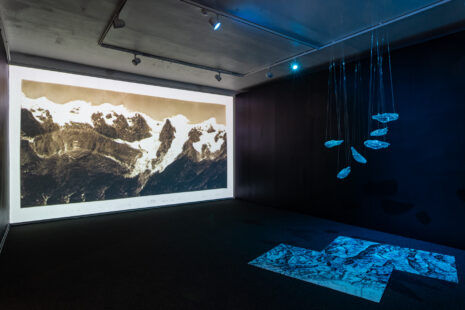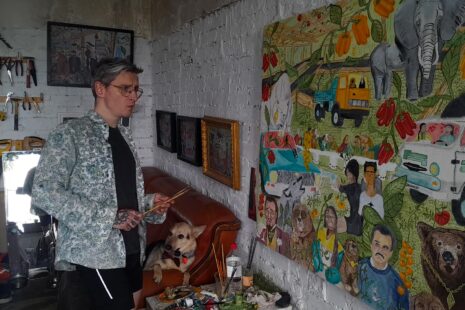What separates EKKM from other galleries or exhibition halls in Tallinn?
The primary difference lies in the history of the EKKM and its birth, starting between the end of 2006 and the beginning of 2007 – the time, when the idle building next to Tallinn City Hall was squatted. In May 2007, the first exhibition “Work Feeds” was set up under the name of EKKM.

Photo by Dénes-Farkas supposedly from the first visit to the then abandoned building which later became EKKM.
Another important difference is that EKKM is firstly created for the art field itself, and only then the audience starts to play a part. As we do not have regular funding, even though we are funded publicly, we are so to say free from “public service function”. Therefore, we can decide on our own activities, take responsibility for ourselves and the field and we don’t have to justify our decisions to financiers or the audience. So, EKKM could also be seen as a sector-specific support structure, supporting art field and its players, in addition to coordinating exhibitions.
The purpose of EKKM, despite its name – Contemporary Art Museum of Estonia – , has never been to become an ordinary art museum, but rather to remain a playful and flexible platform for contemporary art.
This “mindset” is also supported by the lack of stable funding and agreed plans for the future, which of course makes us much more dependent on external factors. EKKM’s house belongs to the city, but we do not have a long-term agreement with them – it all forces us to be more flexible and more responsive to change.
And yet another, but definitely not the last difference, is that EKKM does not expect the visitors to pay for a ticket, which presents our premises as a part of a wider public space – there is not too much public space in Tallinn anyway, most public spaces with free entrance are set up for commercial purposes.
How do you choose the exhibitions that the EKKM will reach the audience?
EKKM acts as a project-initiator and productive institution meaning we usually do not accept project proposals as we prefer a different approach. Instead of choosing from several projects, we pick curators or artists with whom we believe we could have a fruitful and interesting co-operation, and who deals with topics which have not been covered more broadly yet or require more attention. After choosing an artist or a curator, we offer the possibility of carte blanche with EKKM, so the development of the art project only starts after finding the right partners.
Usually we make the commitments with the artist around one year before the exhibition, so the creative minds could dedicate themselves on the exhibition and also have so space and time for manoeuvring. For a year, the selected curators or artists act as part of our EKKM’ team and the projects usually start to unfold in dialogue with us. We also provide necessary structure of support to the artists, in terms of acquisition of resources, paperwork, and in finding right contacts, etc., so that artists/curators could focus on the creative work.
So, as you can see, we cooperate more with curators, because it is more challenging to find funding for preparing solo exhibitions for artists, especially regarding Estonian artists. That’s why we’ve only exhibit a personal-show once in two years. To prepare exhibitions with international artists it is possible to find additional funds abroad, which is why we have organised them more recently.

Opening of an exhibition. Photo: Helen Melesk
EKKM is a seasonal museum, open from spring to autumn. Are you considering becoming a year-round art hall?
EKKM has never undergone extensive renovation work, but at the same time, each exhibition has added something to the general atmosphere and conditions of the house. The current state of the EKKM building is essentially the result of the exhibition activities of the last 12 years. Having the doors open for year-round has been discussed, but in addition to heating issues, winter period would lead to greater maintenance costs we cannot manage as for now. And as said before, the future of EKKM is unclear, so unfortunately, we cannot do very long-term plans.
In recent years, we have been open from April to December and during the winter months EKKM café has taken over the lower floor of the house. The upper floors are usually empty and unheated during this off-season. However, last winter we keep the whole building warm for the first time, so artist Sigrid Viir moved to the studio already in December to prepare for “The Brave Warrior” exhibition opened in April. Similarly, in the future, in winter time we plan to use the upper floors as studios for artists preparing their shows for summer period.
Although we do not have exhibitions in the premises in winter, this does not mean that we do not work in the winter – it is the time for reporting and summaries of the last and preparation for the next season. Only 2,5 people operate in EKKM daily – two directors and 0,5 curator project manager – me, Johannes Säre and Laura Toots.
As usually, also our small team is a multitasker and we all are involved in every show.
For example, the season started with the show “The Brave Warrior” by Siiri Viir – the set up was mostly done by our own resources, skills and (free) time. Of course, there is an extended group of artists and helpers involved when setting up the exhibitions like Dénes Farkas, Villem Säre, Mihkel Säre, Hans-Otto Ojaste, Henri Eek, Taavi Suisalu, etc.
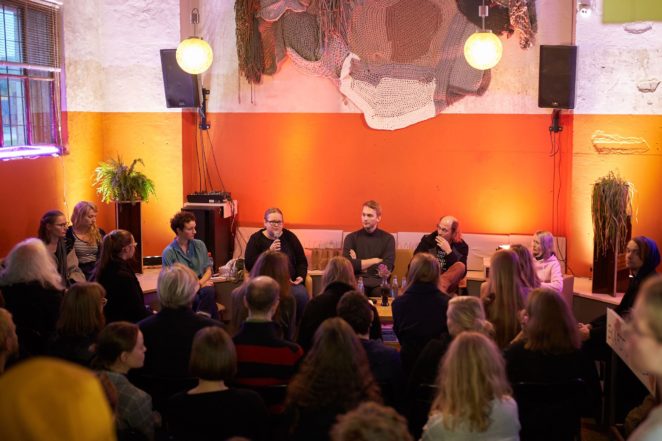
EKA Photo 20 Club gatehering at the cafe at EKKM. Photo: Martin Buschmann
What are the most important exhibitions EKKM this season, which should definitely be seen?
Of course, I recommend you to see everything because the season as a whole is an important project for us. Every year, we bring out four projects which are about on the same level. In the middle of July, we will open an essay exhibition “XENOS” curated by Andres Härm – the show looks at strangers and the relationship with “outside” and “inside” strangers. In September, the opening exhibition of Tallinn Photo Month 2019 -“When you say we Belong to the Light, we Belong to a Thunder” – which is based on the current environmental problem. The curator of the exhibition is Belgian Heidit Ballet, living and working in Berlin.
The exhibition season is completed by a joint curator project of the Center for Contemporary Arts (KKEK), working under the title “Tunnel”, which explores how we could work better as a society, taking into account the deadlock of individualistic thinking and the rise of populist nationalism. In addition, some smaller-scale projects will be launched this year and there are a few foreign exhibitions planned for the beginning of the new year. And when it comes to 2020, I would keep that a secret.
____
EKKM has been producing exhibitions and collecting art from 2007 and since 2010 has established its regular exhibition season that takes place from April until December. In 2011 EKKM initiated its own contemporary art prize, the Köler Prize, that is accompanied by an exhibition of the nominees. 2013 marks the opening of Lugemik Bookshop alongside the offices of the exhibition production company Valge Kuup. Since 2014 the student gallery ISFAG and project-space-like EKKM’s Café followed.

